Picotron Roguelike Tutorial
A tutorial for making a basic roguelike using Picotron
Project maintained by seawaffle Hosted on GitHub Pages — Theme by mattgraham
Items and Inventory
In Part 7, we made the beginnings of our user interface, which lets us see all sorts of things. But why are we in the dungeon to begin with? Sure, beating up bad guys is its own reward, but what we really want is the shiny, shiny loot. So today, we’re going to start working on making some cool items and a big old sack for you to store them in. Let’s start with those classics of dungeons, the healing potion. Pop over to the sprite editor and make your best bottle, and fill it with the reddest liquid possible. We all know healing is red.
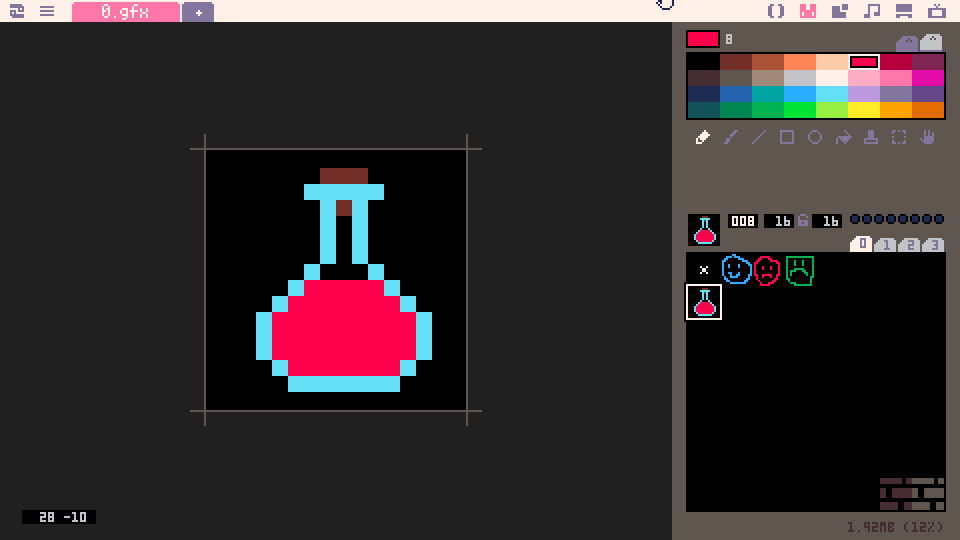
Hey, maybe I’m getting better at this! That’s a pretty good potion. Hopefully yours looks great too. Now all we have to do is plop them around the dungeon. Off to mapgen.lua!
-- mapgen.lua
maxItemsPerRoom = 1
...
-- generate a random map
function populateMap()
-- generate a random amount of rooms
local rooms = {}
for count = 0, maxRooms do
local width = generateRandomNumber(minSize, maxSize)
local height = generateRandomNumber(minSize, maxSize)
local posX = generateRandomNumber(0, mapWidth - width - 1)
local posY = generateRandomNumber(0, mapHeight - height - 1)
local room = RectRoom:new(posX, posY, width, height)
local good = true
-- if the room intersects with another, we're going to toss
-- it out and keep going
for otherRoom in all(rooms) do
if otherRoom:intersects(room) then
good = false
end
end
if good then
add(rooms, room)
-- place player in the first room, enemies can be in any of the others
if count == 0 then
local x = generateRandomNumber(posX+1, posX + width)
local y = generateRandomNumber(posY+1, posY + height)
placePlayer(x, y)
else
-- use this instead of generateRandomNumber function because it is inclusive
local enemyCount = flr(rnd(maxEnemiesPerRoom + 1))
while (enemyCount > 0) do
local x = generateRandomNumber(posX+1, posX + width)
local y = generateRandomNumber(posY+1, posY + height)
placeEnemy(x, y)
enemyCount = enemyCount - 1
end
local itemCount = flr(rnd(maxItemsPerRoom + 1))
while (itemCount > 0) do
local x = generateRandomNumber(posX+1, posX + width)
local y = generateRandomNumber(posY+1, posY + height)
placeItem(x, y)
itemCount = itemCount - 1
end
end
end
end
-- fill all map tiles with wall, except for tiles that are in a room
for y = 0, mapHeight do
for x = 0, mapWidth do
local tile = wall
local index = (y * mapWidth) + x
for room in all(rooms) do
if room:inRoom(x, y) then
tile = floor
end
end
mapTiles[index] = tile
end
end
-- tunnel between all rooms
for index = 1, count(rooms) - 1 do
local room1 = rooms[index]
local room2 = rooms[index + 1]
tunnel = cocreate(tunnelBetween)
while costatus(tunnel) != "dead" do
local status, curr = coresume(tunnel, room1, room2)
if costatus(tunnel) != "dead" then
local index = (curr.y * mapWidth) + curr.x
mapTiles[index] = floor
end
end
end
end
function placeItem(x, y)
if getEntity(x, y) then
return
end
local item = Entity:new({x=x, y=y, sprite=8, name="Healing Potion"})
add(entities, item)
end
So, we’re basically copying the enemy spawning logic, but for items. Right now we only have the one item, so the placeItem() function is pretty simple. I’ve replaced the loop through all entities with a call to getEntity(), you can do that in placeEnemy() as well, if you’re feeling up to it. Let’s see it in action!
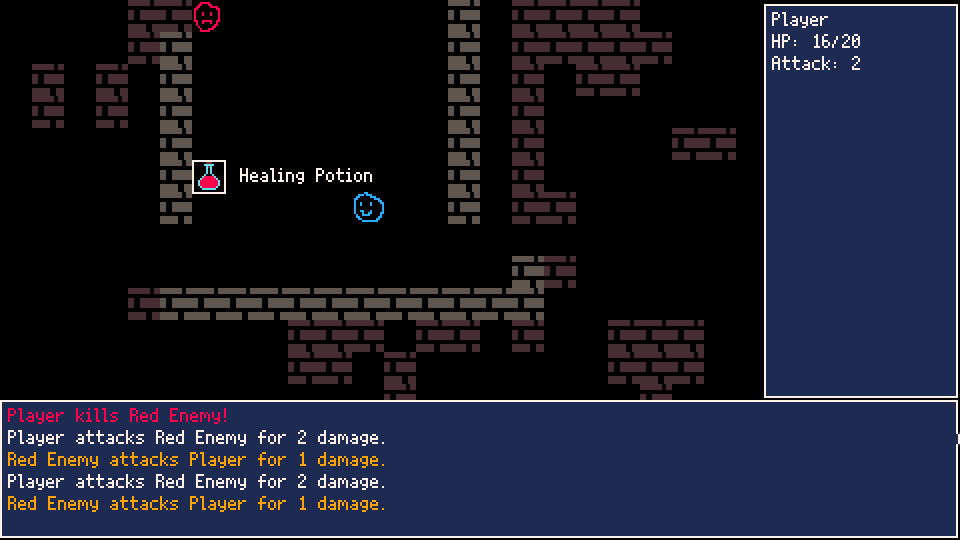
There it is, our healing potion, in all its glory. But what good is a potion if we can’t pick it up and chug it? We need to make an inventory. Head on over to entities.lua.
-- entities.lua
-- constructor for generic entity
function Entity:new(args)
local o = setmetatable({}, Entity)
o.x = args.x
o.y = args.y
o.sprite = args.sprite or 0
o.name = args.name or ""
o.blocksMovement = args.blocksMovement or false
o.combatant = args.combatant or false
o.hp = args.hp or 0
o.maxHp = args.maxHp or o.hp
o.attack = args.attack or 0
o.inventory = args.inventory or {}
o.consumable = args.consumable or false
return o
end
-- add a given entity to the player's inventory
function Entity:pickUp(target)
if self == player then
if not target.combatant then
-- add to inventory
add(self.inventory, target)
log("\f7" .. self.name .. " picks up a " .. target.name)
-- remove from global entities list
del(entities, target)
end
end
end
...
-- return item at the given coords
function getItem(x, y)
for entity in all(entities) do
if entity.x == x and entity.y == y then
if not entity.combatant then
return entity
end
end
end
end
Here, we’ve added a couple items to our generic Entity. First, a table for its inventory. For everyone except the player, it’s going to be empty, but there’s nothing stopping an enemy from having a potion in its bag. We also add a flag to tell us if something is consumable or not, because you generally don’t want an infinite use health potion (unless you do, it’s your game!). There’s a couple new functions: Entity:pickUp() and getItem(). getItem() is extremely similar to getEntity(), except it specifically filters out anything that has the combatant flag, giving us only items. Finally Entity:pickUp() let’s the player grab items and add them to the inventory table, removing them from the global entities table (which makes it disappear from the screen). There’s a couple more things we need to add before trying it out. First, let’s go to mapgen.lua and modify our healing potion to have the consumable flag.
-- mapgen.lua
...
function placeItem(x, y)
if getEntity(x, y) then
return
end
local item = Entity:new({x=x, y=y, sprite=8, name="Healing Potion", consumable=true})
add(entities, item)
end
That’s not completely necessary right now, since we’re not working on using the potion yet, but it’ll be needed in the future. Then we’re going to head on over to main.lua and make some modifications to let us pick it up. Right now, we’re just going to use the button (button 4, or Z on the keyboard) we use for log view, just for testing.
-- main.lua
...
function _update()
if currentState == State.PLAYER_TURN then
if player.hp <=0 then
currentState = State.GAME_OVER
return
end
if btnp(0) then
player:move(-1, 0)
elseif btnp(1) then
player:move(1, 0)
elseif btnp(2) then
player:move(0, -1)
elseif btnp(3) then
player:move(0, 1)
elseif btnp(4) then
-- logIndex = 0
-- currentState = State.LOG_VIEW
local item = getItem(player.x, player.y)
if item then
player:pickUp(item)
end
elseif btnp(5) then
examineCursor = {x=player.x, y=player.y}
currentState = State.EXAMINE
end
updateFOV()
updateMap()
elseif currentState == State.ENEMY_TURN then
updateEntities()
currentState = State.PLAYER_TURN
elseif currentState == State.GAME_OVER then
if btnp(5) then
currentState = State.PLAYER_TURN
entities = {}
populateMap()
logs = {}
log("Welcome back to the dungeon!")
end
elseif currentState == State.LOG_VIEW then
if btnp(4) then
currentState = State.PLAYER_TURN
elseif btnp(2) then
if logIndex > 0 then
logIndex = logIndex - 1
end
elseif btnp(3) then
if logIndex < count(logs) then
logIndex = logIndex + 1
end
end
elseif currentState == State.EXAMINE then
if btnp(5) then
currentState = State.PLAYER_TURN
elseif btnp(0) then
examineCursor.x = examineCursor.x - 1
elseif btnp(1) then
examineCursor.x = examineCursor.x + 1
elseif btnp(2) then
examineCursor.y = examineCursor.y - 1
elseif btnp(3) then
examineCursor.y = examineCursor.y + 1
end
end
end
You can see we’ve commented out what we had when we press button 4 on the player’s turn, and replaced it with picking up an item. Let’s give it a go real fast.
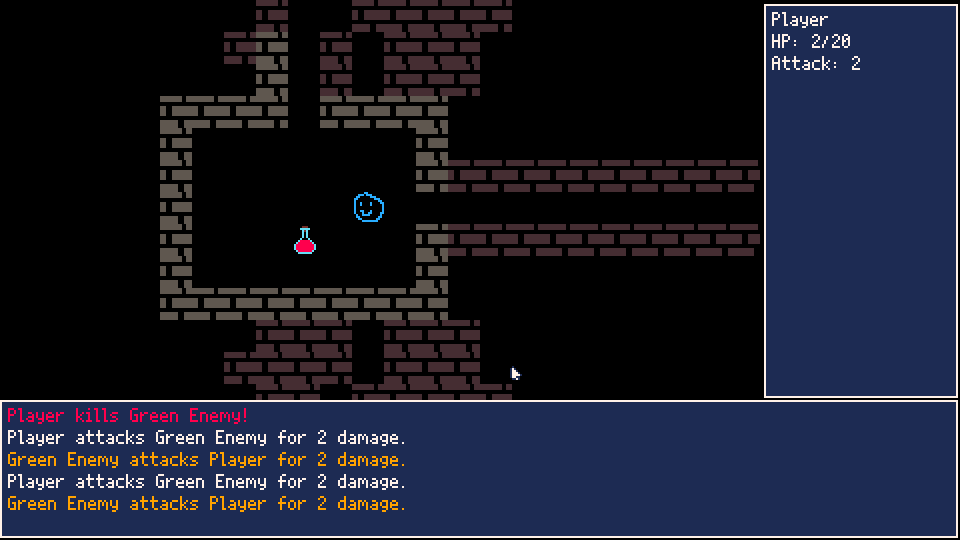
It works, but we’ve got a pretty big problem: we had to get rid of the button to enter log view to be able to do it. If we were making a roguelike using some other framework, we’d just map all these things to different buttons on the keyboard. While you can do that in Picotron, it’s really more of a controller-centric system. So, let’s come up with a way to handle these things with less buttons.
Things that we want front and center, like picking up items and looking at the world, should probably be easily accessible with buttons, while the rest of the stuff can be tucked away in some sort of menu, just like you’d do in a traditional JRPG or something. I’m going to stick to the following button conventions from here on out:
- Buttons 0-3 - Directional buttons. Used for moving the character, and navigating through menus.
- Button 4 - Z on the keyboard, O on a controller. Used for picking up items, or for selecting something in a menu
- Button 5 - X on the keyboard, X on a controller. Used for exiting out of menus, or for entering examine mode.
- Button 6 - Enter on the keyboard, Start on a controller. Used for entering the menu screen. I think with this, we can pretty much handle everything we need to do. We’re departing a bit from traditional roguelikes a bit, since one of the core pieces there is that you should be able to do most things without navigating through menus, but working within limitations is part of the fun of Picotron!
Note: I know that Picotron technically accepts more controller buttons as well. It gives us two sets of directional input, four face buttons, two shoulder buttons and the menu button. I’m choosing to ignore some of this because I feel that if we’re working with keyboard, it’s a little uncomfortable to use. I want this to be playable both on controller and keyboard, and I feel this is the best way to go about it.
Now that we have an idea of how we want our final control scheme, let’s go about implementing things! We’re going to make a lot of changes in main.lua.
-- main.lua
State = {PLAYER_TURN=1, ENEMY_TURN=2, GAME_OVER=3,
EXAMINE=4, MENU=5, INVENTORY=6, LOG_VIEW=7}
window{
pauseable = false
}
menuItems = {"Inventory", "Logs"}
...
function _update()
if currentState == State.PLAYER_TURN then
updatePlayerTurn()
elseif currentState == State.ENEMY_TURN then
updateEntities()
currentState = State.PLAYER_TURN
elseif currentState == State.GAME_OVER then
updateGameOver()
elseif currentState == State.LOG_VIEW then
updateLogView()
elseif currentState == State.EXAMINE then
updateExamine()
elseif currentState == State.MENU then
updateMenu()
elseif currentState == State.INVENTORY then
updateInventory()
end
end
function updatePlayerTurn()
if player.hp <=0 then
currentState = State.GAME_OVER
return
end
if btnp(0) then
player:move(-1, 0)
elseif btnp(1) then
player:move(1, 0)
elseif btnp(2) then
player:move(0, -1)
elseif btnp(3) then
player:move(0, 1)
elseif btnp(4) then
local item = getItem(player.x, player.y)
if item then
player:pickUp(item)
end
elseif btnp(5) then
examineCursor = {x=player.x, y=player.y}
currentState = State.EXAMINE
elseif btnp(6) then
menuSelection = 1
currentState = State.MENU
end
updateFOV()
updateMap()
end
function updateGameOver()
if btnp(5) then
currentState = State.PLAYER_TURN
entities = {}
populateMap()
logs = {}
log("Welcome back to the dungeon!")
end
end
function updateMenu()
if btnp(2) then
if menuSelection > 1 then
menuSelection = menuSelection - 1
end
elseif btnp(3) then
if menuSelection < count(menuItems) then
menuSelection = menuSelection + 1
end
elseif btnp(4) then
local value = State.MENU + menuSelection
currentState = State[fetchState(value)]
logIndex = 0
inventoryIndex = 0
elseif btnp(5) or btnp(6) then
currentState = State.PLAYER_TURN
end
end
function fetchState(value)
for k,v in pairs(State) do
if v == value then
return k
end
end
end
function updateExamine()
if btnp(5) then
currentState = State.PLAYER_TURN
elseif btnp(0) then
examineCursor.x = examineCursor.x - 1
elseif btnp(1) then
examineCursor.x = examineCursor.x + 1
elseif btnp(2) then
examineCursor.y = examineCursor.y - 1
elseif btnp(3) then
examineCursor.y = examineCursor.y + 1
end
end
function updateLogView()
if btnp(5) then
currentState = State.PLAYER_TURN
elseif btnp(2) then
if logIndex > 0 then
logIndex = logIndex - 1
end
elseif btnp(3) then
if logIndex < count(logs) then
logIndex = logIndex + 1
end
end
end
function updateInventory()
if btnp(5) then
currentState = State.PLAYER_TURN
elseif btnp(2) then
if inventoryIndex > 0 then
inventoryIndex = inventoryIndex - 1
end
elseif btnp(3) then
if inventoryIndex < count(player.inventory) then
inventoryIndex = inventoryIndex + 1
end
elseif btnp(4) then
-- use item
end
end
...
function drawSideUI()
drawWindow(382, 2, 478, 198)
cursor(386, 6)
print(player.name)
print("HP: " .. player.hp .. "/" .. player.maxHp)
print("Attack: " .. player.attack)
end
function drawBottomUI()
drawWindow(0, 200, 478, 268)
cursor(4, 204)
local logData = mostRecentLogs(5)
for log in all(logData) do
print(log)
end
end
function drawWindows()
if currentState == State.GAME_OVER then
drawGameOver()
elseif currentState == State.LOG_VIEW then
drawLogView()
elseif currentState == State.MENU then
drawMenu()
elseif currentState == State.INVENTORY then
drawInventory()
end
end
function drawWindow(sx, sy, dx, dy, title)
rectfill(sx, sy, dx, dy, 1)
rect(sx, sy, dx, dy, 7)
if title then
local windowMiddle = sx + ((dx - sx) / 2)
local len = print(" " .. title .. " ", 0, -200)
local titleX = windowMiddle - len / 2
print("\#1 " .. title .. " ", titleX, sy-2, 7)
end
end
function drawGameOver()
drawWindow(20, 50, 460, 220, "Game Over")
cursor(200, 80)
print("You Died")
print("Press X to restart")
end
function drawLogView()
drawWindow(20, 50, 460, 220, "Logs")
cursor(28, 58)
-- starting at logIndex, display 15 messages
for i=1,15 do
local currentIndex = logIndex + i
if currentIndex <= count(logs) then
print(logs[currentIndex])
end
end
end
function drawMenu()
drawWindow(100, 50, 360, 220, "Menu")
cursor(108, 58)
for item = 1, count(menuItems) do
local textColor = 7
if menuSelection == item then
textColor = 8
end
print("\f" .. textColor .. menuItems[item])
end
end
function drawInventory()
drawWindow(20, 50, 460, 220, "Inventory")
cursor(28, 58)
if count(player.inventory) > 0 then
for i = 1, count(player.inventory) do
print(player.inventory[i].name)
end
end
end
Oh my goodness! That’s so much stuff. Good on you for looking at it. Let’s step through what we did a piece at a time.
- We modified our State table. Changing the strings over to numbers facilitates a little trick we’re going to do later. Also, we’ve swapped some things around, also to make this trick work.
- Adding the
windowcall at the beginning of the program lets us modify some of the behind-the-scenes properties of a Picotron program. For instance, settingpauseable=falsedisables the default behavior of the Menu button (Enter on the keyboard), allowing us to use that button for our own purposes. Helpful! - The
menuItemstable will list all of our entries in the main menu, which we’ll see later. - Look at that refactor for the
_update()function! We’ve been talking about it for a while, and here it is. Everything is so much cleaner in that function, but now we’ve got a ton more functions. Everything in its right place though. - In
updatePlayerTurn(), we’ve added the button handler for the Menu button. This sets a variable to track what we’re selecting in the main menu (menuSelection) - We have the main menu update function:
updateMenu(). It lets you change your menu selection by pressing up or down, select something using O (or Z on the keyboard) and exit out by pressing X. The trick we were talking about earlier happens in the selection code. We add the value ofState.MENUto our selection index, and then grab the state key associated with that value (infetchState()). This relies on our States being in a certain order, and that order matching the items in menuItems. As long as we keep that stuff nice and clean, it works like a charm! - In
updateInventory()we handle the logic for navigating our inventory. I haven’t added anything about selecting the item yet, because we haven’t started working on item logic yet, but it’s coming, don’t worry! - We’ve made a new generic function for drawing interface windows:
drawWindow(). It’ll do the basic Final Fantasy-style blue window, white border that we’ve been using for everything. In addition, you can pass a window title in, and it’ll center it on the top of the window, so we don’t get confused when navigating menus. (Note the\#we add to the window title string, that lets us specify background color, just like\flets us specify text color. This is so we can make a gap in the border so the text is clearly visible.) - We’ve got new draw functions,
drawMenu()anddrawInventory(). They do exactly what you think they do. Note that we’re dealing with how to display currently selected items by changing their text color to red. I feel like maybe shading a rectangle behind the selection might be nicer, but I am so lazy.
Whew! Let’s take a look at all this in action!
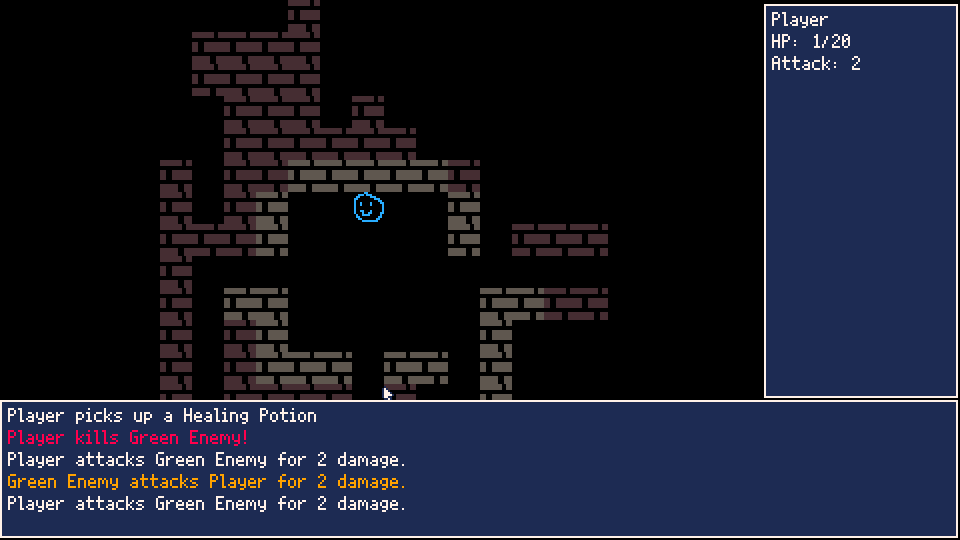
So what’s left? Surely we’re done, right? Not quite. We still need to be able to use an item, and we need to be able to get rid of items we don’t want. Let’s head back in to entities.lua.
-- entities.lua
...
-- constructor for generic entity
function Entity:new(args)
local o = setmetatable({}, Entity)
o.x = args.x
o.y = args.y
o.sprite = args.sprite or 0
o.name = args.name or ""
o.blocksMovement = args.blocksMovement or false
o.combatant = args.combatant or false
o.hp = args.hp or 0
o.maxHp = args.maxHp or o.hp
o.attack = args.attack or 0
o.healing = args.healing or 0
o.inventory = args.inventory or {}
o.consumable = args.consumable or false
o.activationFunction = args.activationFunction or nil
return o
end
...
-- generic function for using an item
function Entity:use(item)
if item.activationFunction then
item.activationFunction(self, item)
log("\f7" .. self.name .. " uses " .. item.name)
if item.consumable then
del(self.inventory, item)
end
end
end
-- function for dropping an item
function Entity:drop(target)
-- set coordinates of the item to the coordinates of the entity dropping it
target.x = self.x
target.y = self.y
-- add item to global entities list
add(entities, target)
-- remove from inventory
del(self.inventory, target)
log("\f7" .. self.name .. " drops " .. target.name)
end
...
-- function for healing items
function heal(user, item)
if item.healing > 0 then
local healed = user.hp + item.healing
if healed > user.maxHp then
healed = user.maxHp
end
printh(user.name .. " heals for " .. item.healing)
log("\f3" .. user.name .. " heals for " .. item.healing .. " HP!")
user.hp = healed
end
end
So, we’ve added some variables to our base Entity. First, we add a healing value. It’ll only be used by healing items, but it’s better than doing something like negative attack. Then, we add an activationFunction variable, which holds a function to be called when the item is used. This will let us have a ton of different features without having to have a lot of weird stuff inside the Entity. Later on down the file, we make Entity:use() (and Entity:drop(), though we’re not going to handle that yet). They do what you expect: If you’re using an item, you call the activation function. If the item is consumable, it disappears after you use it. Finally, we define a heal() function, which adds the item’s healing value to the user’s current hp. Next, we’ll pop over to main.lua.
-- main.lua
...
function updateInventory()
if btnp(5) then
currentState = State.PLAYER_TURN
elseif btnp(2) then
if inventoryIndex > 1 then
inventoryIndex = inventoryIndex - 1
end
elseif btnp(3) then
if inventoryIndex < count(player.inventory) then
inventoryIndex = inventoryIndex + 1
end
elseif btnp(4) then
-- use item
player:use(player.inventory[inventoryIndex])
end
end
Pretty simple. We’ve just added a call to the Entity:use() function when pressing O, which will let us kick off the item usage process. Finally, let’s head over to mapgen.lua to modify the instantiation of our healing potions to make sure they do the stuff we expect.
-- mapgen.lua
...
function placeItem(x, y)
if getEntity(x, y) then
return
end
local item = Entity:new({x=x, y=y, sprite=8, name="Healing Potion",
consumable=true, healing=4, activationFunction=heal})
add(entities, item)
end
We’ve just added the healing argument to the potion’s constructor, and provided a reference to the heal() function for our item’s activation. Let’s give it a try.
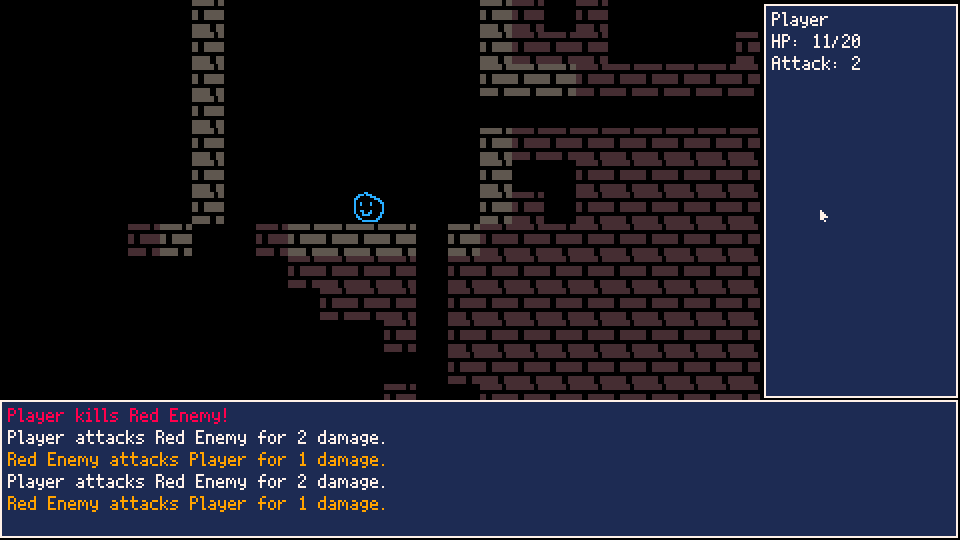
Hooray! We selected the potion, used it, and it appropriately disappeared from our inventory. Everything’s working as expected so far. There’s only one problem: How can we drop our item? As of right now, all the buttons we’re using are used up! We’re going to need to have a context menu to give us additional options when we select an item. Back into main.lua once again.
-- main.lua
...
context = false
ItemState = {USE="Use", DROP="Drop"}
...
function updateInventory()
if context then
if btnp(5) then
context = false
elseif btnp(2) then
if contextIndex > 1 then
contextIndex = contextIndex - 1
end
elseif btnp(3) then
if contextIndex < count(contextItems) then
contextIndex = contextIndex + 1
end
elseif btnp(4) then
local value = contextItems[contextIndex]
if value == ItemState.USE then
-- use item
player:use(contextTarget)
elseif value == ItemState.DROP then
-- drop item
player:drop(contextTarget)
end
context = false
end
else
if btnp(5) then
currentState = State.PLAYER_TURN
elseif btnp(2) then
if inventoryIndex > 1 then
inventoryIndex = inventoryIndex - 1
end
elseif btnp(3) then
if inventoryIndex < count(player.inventory) then
inventoryIndex = inventoryIndex + 1
end
elseif btnp(4) then
-- open context menu for item
context = true
contextIndex = 1
contextItems = {}
contextTarget = player.inventory[inventoryIndex]
if contextTarget.consumable then
add(contextItems, ItemState.USE)
end
add(contextItems, ItemState.DROP)
end
end
end
...
function drawInventory()
drawWindow(20, 50, 460, 220, "Inventory")
cursor(28, 58)
if count(player.inventory) > 0 then
for i = 1, count(player.inventory) do
local textColor = 7
if inventoryIndex == i then
textColor = 8
end
print("\f" .. textColor .. player.inventory[i].name)
end
end
if context then
drawWindow(100, 100, 360, 200, contextTarget.name)
cursor(108, 108)
for i = 1, count(contextItems) do
local textColor = 7
if contextIndex == i then
textColor = 8
end
print("\f" .. textColor .. contextItems[i])
end
end
end
As you can see we added a new context flag, and some additional item-specific states that’ll only be used when we’re in an inventory context menu. Then, in the updateInventory() function, we do all the hard work. We change the current logic to only be run if the context flag is false, and we have it set the context flag when we press O on an item. Based on the item’s properties, we add items to the contextItems table, which will determine what is displayed to the user. For instance, if an item is consumable, we want to add ‘Use’, but we probably wouldn’t want that for a sword. Everything should be droppable though, so that one is outside the logic. Then back up to the situation if the context flag is true. You should recognize some of the logic here, because it’s mostly the same as every other menu we’ve made. The only trick here is that we grab the selection we’ve made from contextItems and use that to determine what function we’re going to call when we press O.
Finally, we have the drawInventory() function, where we’re just tacking on the extra drawing logic for the context menu at the end. Again, it should look pretty much like all the menus we’ve made. That drawWindow() helper is really coming in clutch, isn’t it? Let’s see it all in action.
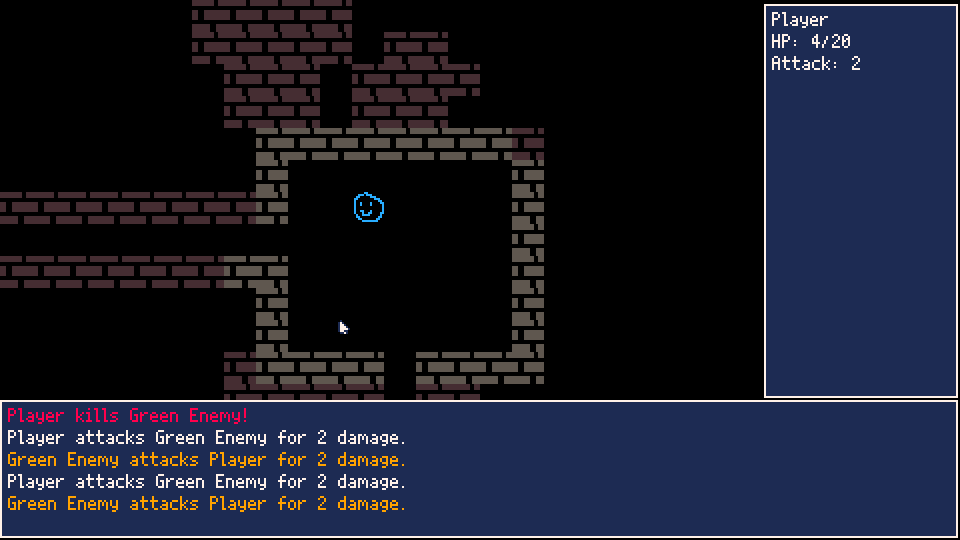
Hey, look at that! The context menu opens up perfectly, the drop function works great, and using an item is still as easy as ever. Well, let me tell you, I am exhausted. I’m sure you are too, this was a lot. Proud of you for sticking with it. Let’s take a well-deserved break. Once again, you can play the current version here. I’ll see you in Part 9!